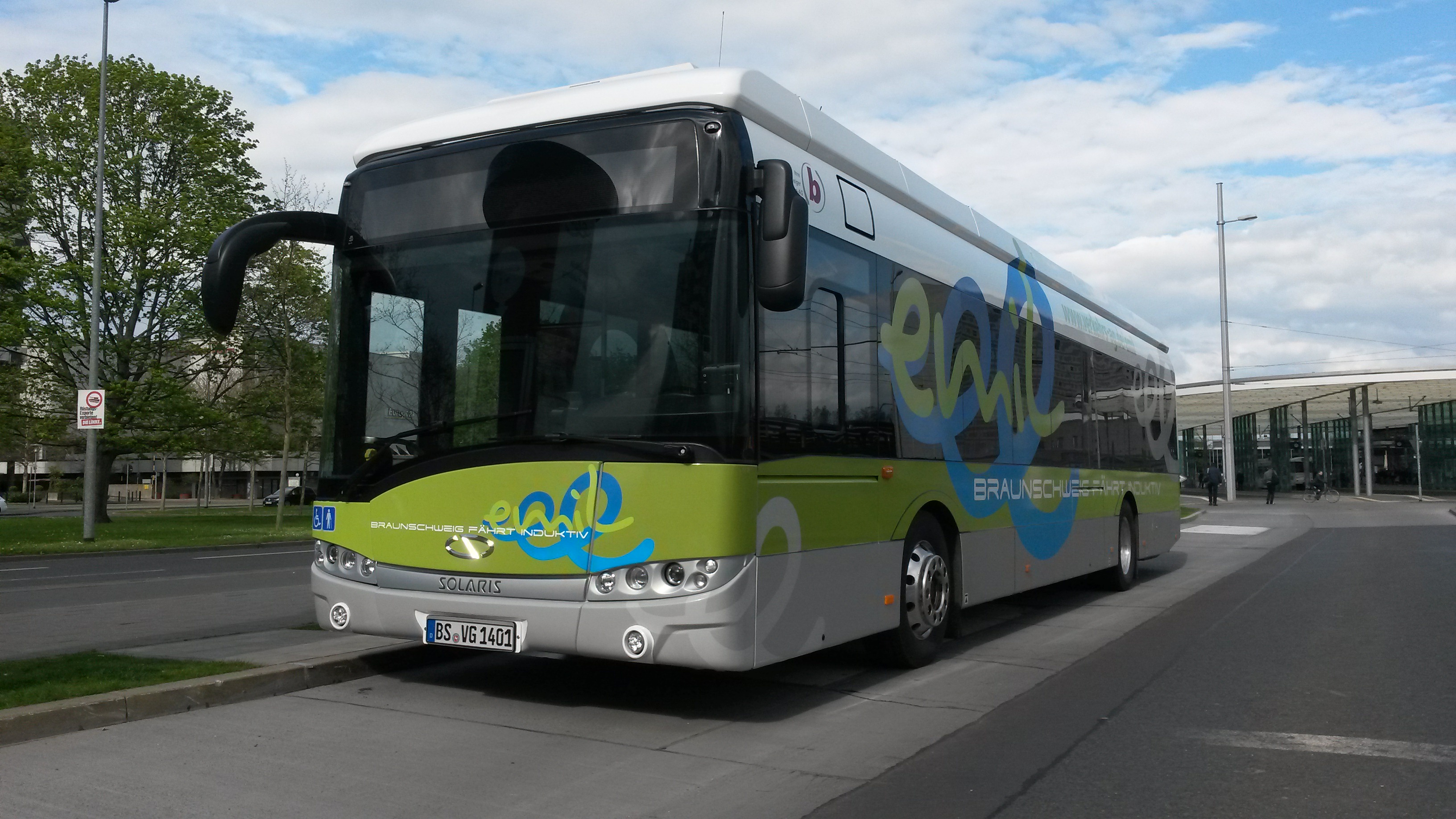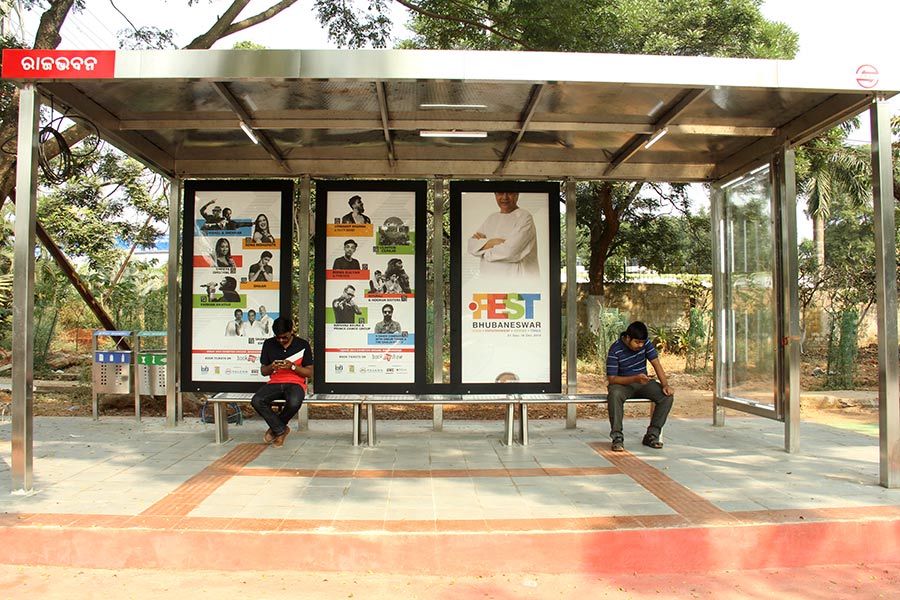|
Battery-electric Bus
A battery electric bus is an electric bus that is driven by an electric motor and obtains energy from on-board batteries. Many trolleybuses use batteries as an auxiliary or emergency power source. In 2018, the National Renewable Energy Laboratory (NREL) found that total operating costs per mile of an electric bus fleet and a diesel bus fleet in the United States are about equal. History The London Electrobus Company started running the first ever service of battery-electric buses between London's Victoria station and Liverpool Street on 15 July 1907. However, the weight and inefficiency of batteries meant that other propulsion technology - such as electric trolleybuses or diesel buses - became commonplace. The first battery buses were mostly small, mini- or midi- buses. The improvement of battery technology from around 2010 led to the emergence of the battery bus, including heavier units such as standard buses and articulated buses. China was the first country to i ... [...More Info...] [...Related Items...] OR: [Wikipedia] [Google] [Baidu] |
Bloomberg News
Bloomberg News (originally Bloomberg Business News) is an international news agency headquartered in New York City and a division of Bloomberg L.P. Content produced by Bloomberg News is disseminated through Bloomberg Terminals, Bloomberg Television, Bloomberg Radio, '' Bloomberg Businessweek'', ''Bloomberg Markets'', Bloomberg.com, and Bloomberg's mobile platforms. Since 2015, John Micklethwait has served as editor-in-chief. History Bloomberg News was founded by Michael Bloomberg and Matthew Winkler in 1990 to deliver financial news reporting to Bloomberg Terminal subscribers. The agency was established in 1990 with a team of six people. Winkler was first editor-in-chief. In 2010, Bloomberg News included more than 2,300 editors and reporters in 72 countries and 146 news bureaus worldwide. Beginnings (1990–1995) Bloomberg Business News was created to expand the services offered through the terminals. According to Matthew Winkler, then a writer for ''The Wall Street Jou ... [...More Info...] [...Related Items...] OR: [Wikipedia] [Google] [Baidu] |
NREL
The National Renewable Energy Laboratory (NREL) in the US specializes in the research and development of renewable energy, energy efficiency, energy systems integration, and sustainable transportation. NREL is a federally funded research and development center sponsored by the Department of Energy and operated by the Alliance for Sustainable Energy, a joint venture between MRIGlobal and Battelle. Located in Golden, Colorado, NREL is home to the National Center for Photovoltaics, the National Bioenergy Center, and the National Wind Technology Center. History The Solar Energy Research, Development and Demonstration Act of 1974 established the Solar Energy Research Institute, which opened in 1977 and was operated by MRIGlobal. Under the Jimmy Carter administration, its activities went beyond research and development in solar energy as it tried to popularize knowledge about already existing technologies, like passive solar. During the Ronald Reagan administration the inst ... [...More Info...] [...Related Items...] OR: [Wikipedia] [Google] [Baidu] |
Overhead Line
An overhead line or overhead wire is an electrical cable that is used to transmit electrical energy to electric locomotives, trolleybuses or trams. It is known variously as: * Overhead catenary * Overhead contact system (OCS) * Overhead equipment (OHE) * Overhead line equipment (OLE or OHLE) * Overhead lines (OHL) * Overhead wiring (OHW) * Traction wire * Trolley wire This article follows the International Union of Railways in using the generic term ''overhead line''. An overhead line consists of one or more wires (or rails, particularly in tunnels) situated over rail tracks, raised to a high electrical potential by connection to feeder stations at regular intervals. The feeder stations are usually fed from a high-voltage electrical grid. Overview Electric trains that collect their current from overhead lines use a device such as a pantograph, bow collector or trolley pole. It presses against the underside of the lowest overhead wire, the contact wire. Current colle ... [...More Info...] [...Related Items...] OR: [Wikipedia] [Google] [Baidu] |
Inductive Charging
Inductive charging (also known as wireless charging or cordless charging) is a type of wireless power transfer. It uses electromagnetic induction to provide electricity to portable devices. Inductive charging is also used in vehicles, power tools, electric toothbrushes, and medical devices. The portable equipment can be placed near a charging station or inductive pad without needing to be precisely aligned or make electrical contact with a dock or plug. Inductive charging is named so because it transfers energy through inductive coupling. First, alternating current passes through an induction coil in the charging station or pad. The moving electric charge creates a magnetic field, which fluctuates in strength because the electric current's amplitude is fluctuating. This changing magnetic field creates an alternating electric current in the portable device's induction coil, which in turn passes through a rectifier to convert it to direct current. Finally, the direct current ch ... [...More Info...] [...Related Items...] OR: [Wikipedia] [Google] [Baidu] |
Regenerative Brake
Regenerative braking is an energy recovery mechanism that slows down a moving vehicle or object by converting its kinetic energy into a form that can be either used immediately or stored until needed. In this mechanism, the electric traction motor uses the vehicle's momentum to recover energy that would otherwise be lost to the brake discs as heat. This method contrasts with conventional braking systems. In those systems, the excess kinetic energy is converted to unwanted and wasted heat due to friction in the brakes, or with rheostatic brakes, where the energy is recovered by using electric motors as generators but is immediately dissipated as heat in resistors. In addition to improving the overall efficiency of the vehicle, regeneration can significantly extend the life of the braking system as the mechanical parts will not wear out quickly. General principle The most common form of regenerative brake involves an electric motor functioning as an electric generator. In elect ... [...More Info...] [...Related Items...] OR: [Wikipedia] [Google] [Baidu] |
Bus Stop
A bus stop is a place where buses stop for passengers to get on and off the bus. The construction of bus stops tends to reflect the level of usage, where stops at busy locations may have shelters, seating, and possibly electronic passenger information systems; less busy stops may use a simple pole and flag to mark the location. Bus stops are, in some locations, clustered together into transport hubs allowing interchange between routes from nearby stops and with other public transport modes to maximise convenience. Types of service For operational purposes, there are three main kinds of stops: Scheduled stops, at which the bus should stop irrespective of demand; request stops (or flag stop), at which the vehicle will stop only on request; and hail and ride stops, at which a vehicle will stop anywhere along the designated section of road on request. Certain stops may be restricted to "discharge/set-down only" or "pick-up only". Some stops may be designated as "timing po ... [...More Info...] [...Related Items...] OR: [Wikipedia] [Google] [Baidu] |
Pantograph (transport)
A pantograph (or "pan" or "panto") is an apparatus mounted on the roof of an electric train, tram or electric bus to collect power through contact with an overhead line. By contrast, battery electric buses and trains are charged at charging stations. The pantograph is a common type of current collector; typically, a single or double wire is used, with the return current running through the rails. The term stems from the resemblance of some styles to the mechanical pantographs used for copying handwriting and drawings. Invention The pantograph, with a low-friction, replaceable graphite contact strip or "shoe" to minimise lateral stress on the contact wire, first appeared in the late 19th century. Early versions include the bow collector, invented in 1889 by Walter Reichel, chief engineer at Siemens & Halske in Germany, and a flat slide-pantograph first used in 1895 by the Baltimore and Ohio Railroad The familiar diamond-shaped roller pantograph was devised and paten ... [...More Info...] [...Related Items...] OR: [Wikipedia] [Google] [Baidu] |
ISO 15118
ISO 15118 ''Road vehicles -- Vehicle to grid communication interface'' is a proposed international standard defining a vehicle to grid (V2G) communication interface for bi-directional charging/discharging of electric vehicles. The standard provides multiple use cases like secure communication, smart charging and the Plug & Charge feature used by some electric vehicle networks. Overview ISO 15118 is one of the International Electrotechnical Commission's (IEC) group of standards for electric road vehicles and electric industrial trucks, and is the responsibility of Joint Working Group 1 (JWG1 V2G) of IEC Technical Committee 69 (TC69) together with subcommittee 31 (SC31) of the International Organization for Standardization's (ISO) Technical Committee 22 (TC22) on road vehicles. ISO and IEC began working together on the standard in 2010, and a Plug & Charge section was released in 2014. No automakers had a productive implementation of the standard by 2018. V2G-PKI ISO 15118 c ... [...More Info...] [...Related Items...] OR: [Wikipedia] [Google] [Baidu] |
SAE J3105
SAE J3105 is a recommended practice for automated connection devices (ACD) that mate chargers with battery electric buses and heavy-duty vehicles. The practice is maintained by the SAE International with the formal title "Electric Vehicle Power Transfer System Using Conductive Automated Connection Devices Recommended Practice", and was first issued in January 2020. It covers the general physical, electrical, functional, testing, and performance requirements for automated conductive DC power transfer systems intended for heavy duty vehicles, focusing primarily on transit buses. J3105 defines a common automated conductive charging system architecture so that any vehicle selecting one of the supplemental specific ACD implementations can use any charger that complies with that specific implementation, regardless of manufacturer, similar to how the earlier IEC 62196, SAE J1772, and SAE J3068 standards define the characteristics for a manually-plugged electric vehicle supply equipment in ... [...More Info...] [...Related Items...] OR: [Wikipedia] [Google] [Baidu] |
Society Of Automotive Engineers
SAE International, formerly named the Society of Automotive Engineers, is a United States-based, globally active professional association and standards developing organization for engineering professionals in various industries. SAE International's world headquarters is in Warrendale, Pennsylvania, 20 miles north of Pittsburgh, Pennsylvania. Principal emphasis is placed on global transport industries such as aerospace, automotive, and commercial vehicles. The organization adopted the name SAE International to reflect the broader emphasis on mobility. SAE International has over 138,000 global members. Membership is granted to individuals, rather than companies. Aside from its standardization efforts, SAE International also devotes resources to projects and programs in STEM education, professional certification, and collegiate design competitions. For historical legacy reasons, the label "SAE" is commonly used on tools and hardware in North America to indicate United States cu ... [...More Info...] [...Related Items...] OR: [Wikipedia] [Google] [Baidu] |


.jpg)



